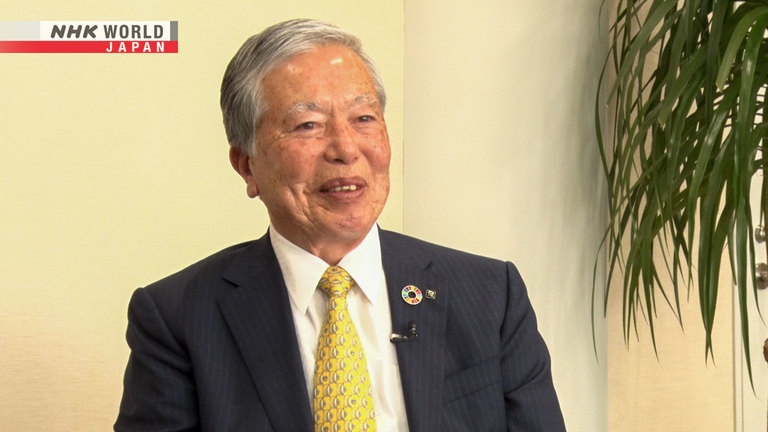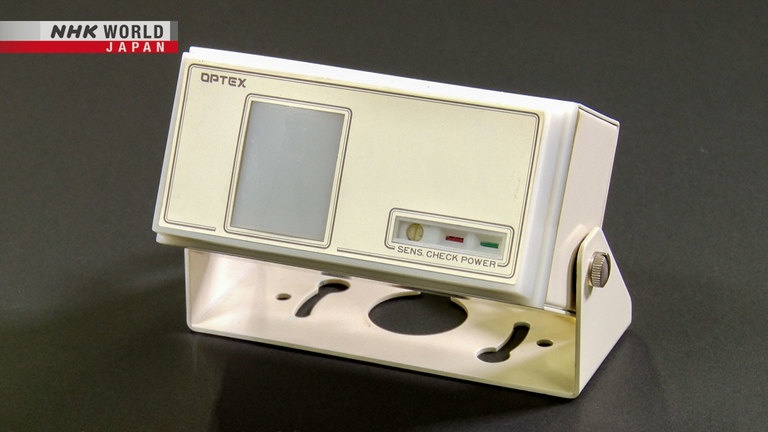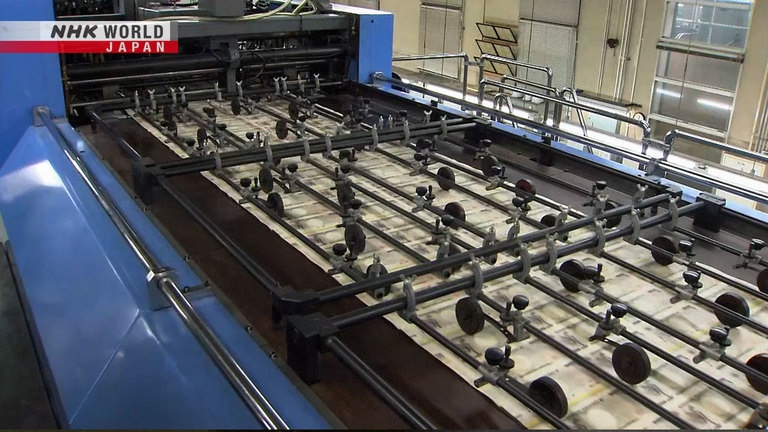Automatic Door Sensors / Banknote Printing Machines
The fascinating stories and secrets behind hit Japanese products, plus parts and machines that boast the top share of niche markets. In the first half: the story behind automatic door sensors which detect people using the far-infrared radiation they emit. In the second half: banknote printing machines used in Japan and around the world, in places like the UK and India.



Transcript
"Japan's Top Inventions"
The behind-the-scenes tales of hit products and creations from Japan.
This is "Japan's Top Inventions."
On today's show,
automatic doors which open as you approach.
Did you know that they work using non-visible light?
Later on the show, a special printing machine.
It's producing Japanese banknotes.
We'll show you some special techniques used to prevent counterfeiting.
Hello. Welcome to "Japan's Top Inventions."
I'm your host, Jason Danielson.
In the first half of the show, we take you "Behind the Creation."
Today's topic is this.
Automatic doors.
Just walk up, and let them open for you.
Above the door is a sensor, which detects when people approach.
That's how the doors know when to open or close.
An early version of this kind of sensor is this model from 1979.
It was developed by a Japanese engineer
who had been working on security devices.
Around 20 kilometers from Kyoto,
the showroom of a major sensor manufacturer.
On display are the latest automatic door sensors.
Non-visible light is coming from there.
Just how is the sensor detecting people?
Here's what the scene looks like using a special camera.
The sensor is putting out infrared radiation,
which can't be seen by the human eye.
This model projects infrared rays on to 60 spots.
When someone steps into this zone,
the sensor detects the infrared being scattered and opens the door.
Our story begins back in 1979.
Large buildings and facilities were being built all over Japan.
Over in Kyoto, an engineer was hard at work.
Kobayashi Toru, age 31,
an employee of a company which made security devices.
It was a small business which made sensors
for security companies to detect intruders.
Kobayashi had to fill multiple roles,
from product development and design, to sales.
When I joined the company, there were only seven other people,
so I did a bit of everything.
Security sensors weren't widely used yet.
As an engineer, it was gratifying to work on something fresh like that.
One day, Kobayashi was sent to talk about their products
at an exhibition for security devices.
As he worked the booth, a visitor brought up something he hadn't thought of before.
"This sensor is for detecting intruders,
but could you use it for automatic doors instead?"
The man was from a company that made automatic doors.
He was asking questions about our product,
and wondering whether our security sensor could work with automatic doors.
I'd only been thinking about security,
so it really opened my eyes to the demand for automatic doors.
At that time, automatic doors were being installed in buildings all over Japan.
You stepped on a mat with a switch underneath to trigger the doors.
But things like rain or high heels could damage the switches.
Also, small children were sometimes too light to activate the switches.
They were called rubber mat switches.
When building one, you made a hole with concrete
and set the mat inside so that it wouldn't move.
That tended to collect water. Rain would get in.
It required a lot of construction work and it broke easily,
so there was demand for something new.
That was how Kobayashi settled on his concept for an automatic door sensor.
He decided to bet on this new idea,
leaving his job to start his own company.
Development started right away.
Kobayashi had a lead on the type of technology he wanted to use.
During his time at the security device company,
he had consulted a research group specializing in infrared radiation.
Through interactions with academic and industry researchers,
he learned about technology which used far-infrared radiation.
We have infrared thermometers now and thermography.
Far-infrared was something like the basis for these kinds of things
before they were common.
There were very few consumer products that used far-infrared
when we were considering it for security devices.
It was the early days.
Far-infrared is emitted by everything with a temperature.
At the time, it was used by the military for things like homing missiles
which detected far-infrared radiation coming from a target.
Humans also emit far-infrared.
If a sensor could pick it up, you would know if someone was approaching.
Kobayashi envisioned a set of doors with a sensor above it.
It would detect the far-infrared from someone walking up.
Then, it would signal the mechanism to open the doors.
The idea was for the far-infrared sensor to read the temperature of the floor.
A person entering the area would cause the temperature to suddenly change,
and the radiation going into the sensor would change suddenly too.
That would be detected and trigger the doors to open.
Kobayashi began work on a prototype,
but there was trouble immediately.
The sensor was about two meters above the floor.
In order to detect the far-infrared emitted by a person,
it would need to be very sensitive.
Was there a sensor up to the task?
Kobayashi researched makers across Japan.
But the applications for far-infrared
were limited to military use or special cases.
Kobayashi couldn't find a single supplier in Japan.
Did the far-infrared sensor component exist?
Kobayashi began looking overseas.
After a long search, he found something promising.
Over in the United Kingdom, a company had a component.
In the end, I was helped by the Infrared Science and Technology society,
which has members in many fields.
Someone that worked in defense pointed me in the right direction.
From that, I was able to find something
after contacting a bunch of different places.
Feeling uncertain but hopeful,
Kobayashi ordered the component from the UK.
It was time to test whether it could detect far-infrared coming from a person.
He installed the part into his prototype, and walked up.
The doors opened.
And so, in November of 1979, after three months of development,
the automatic door sensor which detected people approaching was complete.
Soon after, Kobayashi started selling his automatic door sensors.
Word spread fast about how well they worked,
and around 1,000 units were shipped in just half a year.
It was the perfect start, but trouble was waiting just around the corner.
One day...
the phone rang at the office.
The door keeps opening and closing on its own.
What's wrong with it?
The doors would suddenly open and close and clang about.
Some would just stay open.
We were getting complaints like that.
Just what was going on?
They checked the parts, from the sensor to the door opener,
but nothing was wrong with them.
There was nothing to fix,
so all they could do was give the doors a good cleaning and head back.
We polished up the glass as best we could.
There wasn't anything else to be done,
and we wanted to show that we were being earnest.
But really, I felt like crying because of the situation.
And then, June.
Complaints about the doors started pouring in.
Kobayashi threw himself into finding the cause.
One day, it hit him.
June is the rainy season in Japan.
Maybe it was the heat and high humidity causing the doors to malfunction.
But how could he prove it?
The company was small and lacked equipment.
Unlike a major manufacturer,
they didn't have the proper testing facilities.
But Kobayashi had an idea.
Rice cookers,
a staple of Japanese households.
Put in rice and water, turn it on,
and you have freshly cooked rice in under an hour.
The heat and humidity gets very high inside the cooker as it operates.
You turn on an electric rice cooker with water inside,
and it gets to over 90 degrees in there, full of steam.
The idea was to test the components by putting them in the rice cooker.
Kobayashi went ahead and placed sensor components into a rice cooker.
The heat was turned on.
Then, one hour later.
As expected, moisture had gotten inside the components.
A new component which could keep the moisture out was needed.
Kobayashi contacted multiple companies in Japan
to see whether they could make it.
He knew someone who worked at a major electronics manufacturer in Osaka,
and was able to secure their cooperation.
This new part was placed into the rice cooker for testing.
One hour later.
Kobayashi gingerly picked up a component.
From the outside, it looked totally fine.
But was it still working properly?
Hoping for the best, Kobayashi set up the sensor using the test components.
Nervously, he flipped the switch.
The sensor was on.
He waited, and the doors did not incorrectly open by themselves.
But would it still detect a person?
He slowly approached the doors.
They slid open.
He tried again and again,
and it worked every time.
I was so happy.
It was a new product. We were pioneers.
And we were fixing the technical problems as they came up.
But now it felt like we'd finally worked it all out.
It felt like it was finally complete.
It's been over 40 years since the first model.
Automatic door sensors are now an essential part of our daily lives.
Afterwards, automatic door sensors which detect infrared radiation
became the primary type used around the world.
How do experts view this invention?
We're joined by Kimata Masafumi to learn more.
Welcome to the show.
Thank you.
What was groundbreaking about using far-infrared sensors to detect people?
The impressive thing was the innovation.
Automatic doors at the time had switches that you stepped on.
Your body weight activated the switch.
It's impressive that they thought to change this.
The person approaching the door doesn't have to think about any switches.
I think that was a great step forward.
What other applications are there for technologies which use infrared radiation?
An everyday example would be an ear thermometer.
That uses an infrared sensor to measure your temperature.
Also, there's a temperature sensor inside microwaves.
That relies on infrared as well.
And with COVID now, there are CO2 sensors for air quality.
They measure carbon dioxide, and many of these actually use infrared.
How do you see technologies which use infrared radiation
being used in the future?
Personally, I want to see it being used with vehicles.
Serious traffic accidents involving pedestrians often occur at night.
A car's headlamps, even the high-beam,
only lights up about 100 meters.
But with infrared, and this depends on resolution,
you could detect someone 300 meters away.
Infrared helps with expanding this range.
I hope the technology is built into many vehicles
in order to help eliminate traffic accidents.
Thank you for joining us today. It was good to speak with you.
My pleasure, thank you.
Top Niche Creations.
Our next segment is "Top Niche Creations."
Today, we're looking at banknotes,
a familiar form of money used all over the world.
In order to print a banknote, a device is used which looks like this.
It's a banknote printing machine made by a Japanese printer company.
These machines are used to produce banknotes for around 100 countries
and regions like India, Indonesia, China, and more.
How do these special printers work? We went to find out.
A printer manufacturer in the Greater Tokyo Area.
If you take a look inside the company's showroom,
you'll find this giant device.
This is a banknote printing machine.
It measures 23 meters long, 7 meters wide,
4.5 meters tall, and weighs 100 tons.
Just how does this machine print banknotes?
First, you load in the paper you're going to use here.
Then, the paper moves along toward the printer unit
where the notes are printed.
Here's a look at what's going on inside.
There's a series of rollers with ink and printing plates
moving inside the machine.
As paper passes through these, patterns are pressed on.
Here is actual footage of banknotes being printed.
The bills are printed on the back first, and then the front.
12,000 bills are printed in just one hour.
Next, a machine applies these.
Holograms for preventing counterfeiting.
If you look at the hologram at an angle, the number 10,000 appears.
Finally, the notes are cut to the right size.
This is a finished banknote.
The company's finest printing techniques are all at play here.
Uehara Takeo from the sales department tells us more.
This is a Japanese 10,000 yen bill.
If you look around here or here, you'll find micro letters.
These micro letters are exactly what they sound like.
Difficult to read with the naked eye, but if we magnify...
we can make out the words "NIPPON GINKO",
which means Bank of Japan.
Each letter is only 0.25 millimeters tall.
Also, if you look at the note at an angle,
you can make out the words "NIPPON".
These hidden letters are a type of latent image which requires special printers.
A normal printer wouldn't be able to do this.
What sets the printing machines apart is how well
they can reproduce features like these latent images.
The company is the only one in Japan
which makes banknote printing machines.
It was founded in 1923.
Originally, the company made industrial printers for books with illustrations.
In 1958, with their advanced printer technology,
they created their first banknote printing machine
for Japan's National Printing Bureau.
Since then, they've continued to support Japan's banknote supply
from behind the scenes.
However, they did have a difficult task
from the start with counterfeit prevention.
Each time a new banknote design is put out,
fake bills start circulating.
Whenever new banknotes come out,
you have people who try to make counterfeits.
It's a game of cat and mouse.
In order to fight against that,
you put in stronger anti-counterfeiting measures
and put together different kinds of printing techniques.
The company's printer technology has been repeatedly refined
in the fight against counterfeiting.
Current banknotes contain the latest in anti-counterfeiting measures.
For example, let's look at the numbers or the corner here.
If we zoom in...
we see that the ink is raised compared to the surrounding parts.
More ink was layered on here, creating a subtle embossed effect.
Another feature is in the pattern next to the hologram.
This line changes color partway through as it weaves through other lines.
The same line can change from green to orange,
or orange to green.
It requires very specialized printing techniques
to be able to do this with such a thin line
and make it perfect with no misalignment.
Using these printing techniques,
the company's machines have helped to greatly reduce
the occurrence of counterfeit bills.
The machines have been shipped to over 30 countries and regions to date,
including the UK, Indonesia, Vietnam, and China.
The printers help support the circulation of cash in places around the world.
They're printed papers but real banknotes.
If people lose their trust in them, there's no getting that back.
I'm very proud that our machines are used to
print banknotes in my own home country.
And
I'm also proud of the fact that the machines made by our company
are used not just in Japan,
but also around the world to print banknotes.
It's time for a pop quiz!
The Bank of Japan produces around three billion banknotes a year.
If these banknotes were put into a single stack,
how many times taller than Mount Fuji would it be?
Mount Fuji is 3,776 meters tall.
Pick an answer from one of these three options.
(20 times 40 times 80 times)
And the answer is 80!
Three billion times the thickness of one bill, 0.1 millimeters,
would be 300 kilometers.
That's 80 Mount Fujis!
Just think about all that money being printed each year.
That's all for this episode of "Japan's Top Inventions."
We'll leave you with what came next for the engineer
who developed the automatic door sensors
from the first half of the show.
See you next time, and stay inventive!
(Kobayashi Toru developed the automatic door sensor 40 years ago.)
(The infrared sensor technology was later used for many other purposes.)
(Like for switching on factory lights at night when people pass by.)
(Or for market research to count visitors and determine the flow of people.)
(There's even a sensor for measuring the clarity of water.)
(The search for new applications for infrared sensors continues.)
I was so taken by far-infrared that I started my own company.
So it's really gratifying to see the technology
being applied in this form all around the world.
I think there are still more ways that infrared sensors can make a difference.